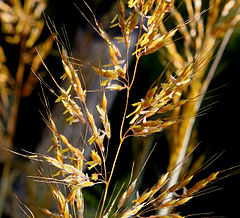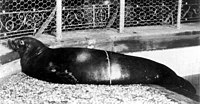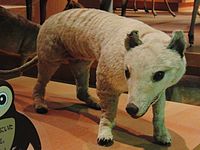ব্যবহারকারী:প্রলয়স্রোত/অনুবাদের কুঁড়েঘর
Hadean Eon[সম্পাদনা]

4000 Ma and earlier.
| Date | Event |
|---|---|
| 4600 Ma | The planet Earth forms from the accretion disc revolving around the young Sun with organic compounds (complex organic molecules) necessary for life having perhaps formed in the protoplanetary disk of cosmic dust grains surrounding it before the formation of the Earth.[১] |
| ৪৫০০ মিলিয়ন বছর পূর্বে | According to the giant impact hypothesis, the Moon was formed when the planet Earth and the hypothesized planet Theia collided, sending a very large number of moonlets into orbit around the young Earth which eventually coalesced to form the Moon.[২] The gravitational pull of the new Moon stabilised the Earth's fluctuating axis of rotation and set up the conditions in which abiogenesis occurred.[৩] |
| ৪৪০৪ মিলিয়ন বছর পূর্বে | পৃথিবীতে প্রথম তরল পানির সৃষ্টি হয় |
| ৪২৮০ মিলিয়ন বছর পূর্বে | পৃথিবীতে প্রথম জীবনের সম্ভাব্য সূত্রপাত হয়।[৪][৫][৬][৭] |
Cenozoic Era[সম্পাদনা]
66 Ma – present



| Date | Event |
|---|---|
| 66 Ma | The Cretaceous–Paleogene extinction event eradicates about half of all animal species, including mosasaurs, pterosaurs, plesiosaurs, ammonites, belemnites, rudist and inoceramid bivalves, most planktic foraminifers, and all of the dinosaurs excluding the birds.[৮] |
| From 66 Ma | Rapid dominance of conifers and ginkgos in high latitudes, along with mammals becoming the dominant species. First psammobiid bivalves. Earliest rodents. Rapid diversification in ants. |
| 63 Ma | Evolution of the creodonts, an important group of meat-eating (carnivorous) mammals |
| 60 Ma | Diversification of large, flightless birds. Earliest true primates,[কে?] along with the first semelid bivalves, edentate, carnivoran and lipotyphlan mammals, and owls. The ancestors of the carnivorous mammals (miacids) were alive.[তথ্যসূত্র প্রয়োজন] |
| 56 Ma | Gastornis, a large flightless bird, appears in the fossil record |
| 55 Ma | Modern bird groups diversify (first song birds, parrots, loons, swifts, woodpeckers), first whale (Himalayacetus), earliest lagomorphs, armadillos, appearance of sirenian, proboscidean, perissodactyl and artiodactyl mammals in the fossil record. Angiosperms diversify. The ancestor (according to theory) of the species in the genus Carcharodon, the early mako shark Isurus hastalis, is alive. |
| 52 Ma | First bats appear (Onychonycteris) |
| 50 Ma | Peak diversity of dinoflagellates and nannofossils, increase in diversity of anomalodesmatan and heteroconch bivalves, brontotheres, tapirs, rhinoceroses, and camels appear in the fossil record, diversification of primates |
| 40 Ma | Modern-type butterflies and moths appear. Extinction of Gastornis. Basilosaurus, one of the first of the giant whales, appeared in the fossil record. |
| 37 Ma | First nimravid ("false saber-toothed cats") carnivores — these species are unrelated to modern-type felines |
| 35 Ma | Grasses diversify from among the monocot angiosperms; grasslands begin to expand. Slight increase in diversity of cold-tolerant ostracods and foraminifers, along with major extinctions of gastropods, reptiles, amphibians, and multituberculate mammals. Many modern mammal groups begin to appear: first glyptodonts, ground sloths, canids, peccaries, and the first eagles and hawks. Diversity in toothed and baleen whales. |
| 33 Ma | Evolution of the thylacinid marsupials (Badjcinus) |
| 30 Ma | First balanids and eucalypts, extinction of embrithopod and brontothere mammals, earliest pigs and cats |
| 28 Ma | Paraceratherium appears in the fossil record, the largest terrestrial mammal that ever lived |
| 25 Ma | Pelagornis sandersi appears in the fossil record, the largest flying bird that ever lived |
| 25 Ma | First deer |
| 20 Ma | First giraffes, hyenas, bears and giant anteaters, increase in bird diversity |
| 15 Ma | Genus Mammut appears in the fossil record, first bovids and kangaroos, diversity in Australian megafauna |
| 10 Ma | Grasslands and savannas are established, diversity in insects, especially ants and termites, horses increase in body size and develop high-crowned teeth, major diversification in grassland mammals and snakes |
| 9.5 Ma | The Great American Interchange, where various land and freshwater faunas migrated between North and South America. Armadillos, opossums, hummingbirds Phorusrhacids, Ground Sloths, Glyptodonts, and Meridiungulates traveled to North America, while horses, tapirs, saber-toothed cats, Jaguars, Bears, Coaties, Ferrets, Otters, Skunks and deer entered South America. |
| 6.5 Ma | First hominins (Sahelanthropus) |
| 6 Ma | Australopithecines diversify (Orrorin, Ardipithecus) |
| 5 Ma | First tree sloths and hippopotami, diversification of grazing herbivores like zebras and elephants, large carnivorous mammals like lions and the genus Canis, burrowing rodents, kangaroos, birds, and small carnivores, vultures increase in size, decrease in the number of perissodactyl mammals. Extinction of nimravid carnivores. |
| 4.8 Ma | Mammoths appear in the fossil record |
| 4 Ma | Evolution of Australopithecus, Stupendemys appears in the fossil record as the largest freshwater turtle, first modern elephants, giraffes, zebras, lions, rhinoceros and gazelles appear in the fossil record |
| 2.7 Ma | Evolution of Paranthropus |
| 2.5 Ma | The earliest species of Smilodon evolve |
| 2 Ma | First members of the genus Homo, Homo Habilis, appear in the fossil record. Diversification of conifers in high latitudes. The eventual ancestor of cattle, aurochs (Bos primigenus), evolves in India. |
| 1.7 Ma | Extinction of australopithecines |
| 1.2 Ma | Evolution of Homo antecessor. The last members of Paranthropus die out. |
| 800 Ka | Short-faced bears (Arctodus simus) become abundant in North America |
| 600 ka | Evolution of Homo heidelbergensis |
| 350 ka | Evolution of Neanderthals |
| 300 ka | Gigantopithecus, a giant relative of the orangutan from Asia dies out |
| 250 ka | Anatomically modern humans appear in Africa.[৯][১০][১১] Around 50,000 years before present they start colonising the other continents, replacing the Neanderthals in Europe and other hominins in Asia. |
| 40 ka | The last of the giant monitor lizards (Varanus priscus) die out |
| 30 ka | Extinction of Neanderthals, first domestic dogs |
| 15 ka | The last woolly rhinoceros (Coelodonta antiquitatis) are believed to have gone extinct |
| 11 ka | Short-faced bears vanish from North America, with the last giant ground sloths dying out. All Equidae become extinct in North America. |
| 10 ka | The Holocene epoch starts 10,000[১২] years ago after the Late Glacial Maximum. The last mainland species of woolly mammoth (Mammuthus primigenus) die out, as does the last Smilodon species. |
| 8 ka | জায়ান্ট লিমু বিলুপ্ত |
ঐতিহাসিক বিলুপ্তকরণ[সম্পাদনা]




| Date | Event |
|---|---|
| ৬০০০ বছর পূর্বে (c. ৪০০০ খ্রিষ্ঠপূর্ব) | আমেরিকার মাস্টোডনের ছোট জনগোষ্ঠী উতাহ এবং মিসিগানে বিলুপ্ত হয়। |
| ৪৫০০ বছর পূর্বে (২৫০০ খ্রিষ্ঠপূর্ন) | বামন উলি ম্যামথের শেষ সদস্য আলাস্কার কাছাকাছি র্যাঙ্গেল থেকে বিলুপ্ত হয়ে যায়। |
| ৬০০ বছর পূর্বে(c. ১৪০০ খ্রিষ্ঠাব্দ) | মোয়া এবং তার শিকারী হাসট ঈগল নিউজিল্যান্ড থেকে বিলুপ্ত হয়ে যায়। |
| টেমপ্লেট:Years ago ya (1627) | The last recorded wild aurochs die out |
| টেমপ্লেট:Years ago ya (1688) | The dodo goes extinct |
| টেমপ্লেট:Years ago ya (1768) | The Steller's sea cow goes extinct |
| টেমপ্লেট:Years ago ya (1883) | The quagga, a subspecies of zebra, goes extinct |
| টেমপ্লেট:Years ago (১৯১৪) | মার্থা, প্যাসেঞ্জার কবুতরের, শেষ সদস্য মারা যায়। |
| টেমপ্লেট:Years ago ya (1936) | থায়ালাসাইন তাসমানিয়ার চিড়িয়াখানা থেকে বিলুপ্ত হয়ে যায়। সে ছিল থাইলাসিনেডে পরিবারের শেষ সদস্য |
| টেমপ্লেট:Years ago ya (1952) | ক্যারাবিয়ান মঙ্ক সিল বিলুপ্ত হয়ে যায়।[১৫] |
| (২০০৮) | বাজি, ইয়াংটেজে নদীর ডলফিন ধীরে ধীরে বিলুপ্ত হয়ে যায়। [১৬] |
| টেমপ্লেট:Years ago ya (২০১১) | ওয়েস্টার্ন ব্ল্যাক রাইনোসোর বিলুপ্ত হয়ে যাওয়ার ঘোষণা দেওয়া হয় |
- ↑ Moskowitz, Clara (মার্চ ২৯, ২০১২)। "Life's Building Blocks May Have Formed in Dust Around Young Sun"। Space.com। Salt Lake City, UT: Purch। সংগ্রহের তারিখ ২০১২-০৩-৩০।
- ↑ Herres, Gregg; Hartmann, William K। "The Origin of the Moon"। Planetary Science Institute। Tucson, AZ। সংগ্রহের তারিখ ২০১৫-০৩-০৪।
- ↑ Astrobio (সেপ্টেম্বর ২৪, ২০০১)। "Making the Moon"। Astrobiology Magazine ("Based on a Southwest Research Institute press release")। New York: NASA। আইএসএসএন 2152-1239। সংগ্রহের তারিখ ২০১৫-০৩-০৪।
Because the Moon helps stabilize the tilt of the Earth's rotation, it prevents the Earth from wobbling between climatic extremes. Without the Moon, seasonal shifts would likely outpace even the most adaptable forms of life.
- ↑ Dodd, Matthew S.; Papineau, Dominic; Grenne, Tor; slack, John F.; Rittner, Martin; Pirajno, Franco; O'Neil, Jonathan; Little, Crispin T. S. (২ মার্চ ২০১৭)। "Evidence for early life in Earth's oldest hydrothermal vent precipitates"। Nature। 543। ডিওআই:10.1038/nature21377। বিবকোড:2017Natur.543...60D। ১০ ফেব্রুয়ারি ২০১৭ তারিখে মূল থেকে আর্কাইভ করা। সংগ্রহের তারিখ ২ মার্চ ২০১৭।
- ↑ Zimmer, Carl (১ মার্চ ২০১৭)। "Scientists Say Canadian Bacteria Fossils May Be Earth's Oldest"। The New York Times। সংগ্রহের তারিখ ২ মার্চ ২০১৭।
- ↑ Ghosh, Pallab (১ মার্চ ২০১৭)। "Earliest evidence of life on Earth 'found'"। BBC News। সংগ্রহের তারিখ ২ মার্চ ২০১৭।
- ↑ Dunham, Will (১ মার্চ ২০১৭)। "Canadian bacteria-like fossils called oldest evidence of life"। Reuters। সংগ্রহের তারিখ ১ মার্চ ২০১৭।
- ↑ Chiappe, Luis M.; Dyke, Gareth J. (নভেম্বর ২০০২)। "The Mesozoic Radiation of Birds"। Annual Review of Ecology and Systematics। Palo Alto, CA: Annual Reviews। 33: 91–124। আইএসএসএন 1545-2069। ডিওআই:10.1146/annurev.ecolsys.33.010802.150517।
- ↑ Karmin M, Saag L, Vicente M, ও অন্যান্য (এপ্রিল ২০১৫)। "A recent bottleneck of Y chromosome diversity coincides with a global change in culture"। Genome Research। Cold Spring Harbor, NY: Cold Spring Harbor Laboratory Press। 25 (4): 459–466। আইএসএসএন 1088-9051। ডিওআই:10.1101/gr.186684.114। পিএমআইডি 25770088। পিএমসি 4381518
 ।
।
- ↑ Brown, Frank; Fleagle, John; McDougall, Ian (ফেব্রুয়ারি ১৬, ২০০৫)। "The Oldest Homo sapiens" (সংবাদ বিজ্ঞপ্তি)। Salt Lake City, UT: University of Utah। সংগ্রহের তারিখ ২০১৫-০৩-১০।
- ↑ Alemseged, Zeresenay; Coppens, Yves; Geraads, Denis (ফেব্রুয়ারি ২০০২)। "Hominid cranium from Homo: Description and taxonomy of Homo-323-1976-896"। American Journal of Physical Anthropology। Hoboken, NJ: John Wiley & Sons for the American Association of Physical Anthropologists। 117 (2): 103–112। আইএসএসএন 0002-9483। ডিওআই:10.1002/ajpa.10032। পিএমআইডি 11815945।
- ↑ "International Stratigraphic Chart (v 2014/10)" (PDF)। Beijing, China: International Commission on Stratigraphy। সংগ্রহের তারিখ ২০১৫-০৩-১১।
- ↑ Blanchard, Ben (ডিসেম্বর ১৩, ২০০৬)। "INTERVIEW-Chinese river dolphin almost certainly extinct"। Reuters। সংগ্রহের তারিখ ২০১৫-১০-১৯।
- ↑ Lovgren, Stefan (ডিসেম্বর ১৪, ২০০৬)। "China's Rare River Dolphin Now Extinct, Experts Announce"। National Geographic News। Washington, D.C.: National Geographic Society। সংগ্রহের তারিখ ২০১৫-১০-১৮।
- ↑ "It's official: Caribbean monk seal is extinct"। msnbc.com। জুন ৬, ২০০৮। সংগ্রহের তারিখ ২০১৫-০৩-১১।
- ↑ "Lipotes vexillifer"। বিপদগ্রস্ত প্রজাতির আইইউসিএন লাল তালিকা। সংস্করণ 2012.2। প্রকৃতি সংরক্ষণের জন্য আন্তর্জাতিক ইউনিয়ন। ২০০৮। সংগ্রহের তারিখ ২০১৫-১০-১৯।
